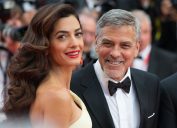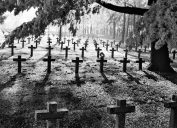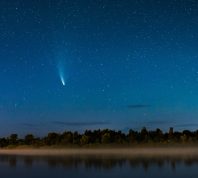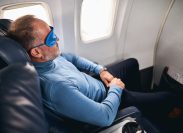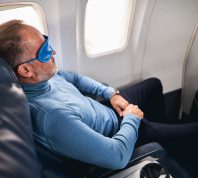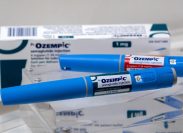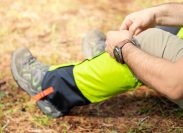Narcos' Michael Stahl-David Talks Colombia, Woody Harrelson, and Why He Left Graffiti Art Behind
The 34 year-old breakout stars in season three of Netflix's hit show.

Michael Stahl-David knows a thing or two about chasing monsters. The 34-year-old actor blew into popular consciousness with a star turn battling (read: running from) whatever-the-heck-that-terrifying-thing-was in the 2008 hit Cloverfield. This fall, he's back, and chasing a different kind of monster in the third season of Narcos. He portrays Chris Feistl, based on a real-life DEA agent, who matched wits and guns battles with the notorious Cali Cartel that assumed power following kingpin Pablo Escobar's inglorious demise.
Stahl-David understands both sides of the law. As a high school student in Chicago—he grew up blocks from Wrigley Field—he spent his free time as a graffiti artist, gaining a reputation as a skilled tagger while also earning "a lengthy arrest record." Following one too many run-ins with the cops, he decided to focus on acting, landing a role in the short-lived NBC sitcom, The Black Donnellys, before his breakout as street smart Rob Hawkins in the J. J. Abrams–produced low-fi monster masterpiece.
This fall, Stahl-David will vault to another level of fame. In addition to Narcos, he features as Bobby Kennedy opposite Woody Harrelson's Lyndon Baines Johnson in Rob Reiner's LBJ. And Stahl-David stars in 2017 SxSW Audience Award-winning The Light Of The Moon. Merely managing his busy schedule is becoming a monster of a task. We chatted with him about filming in Colombia, his favorite Woody Harrelson story, and why he's left his life as a tagger in the rearview mirror.
Photo by Dimitrios Kambouris/Getty Images
Did you talk to the agent you portrayed about his life?
Before we started filming, I went down to Arizona and spent a couple days with him. He talked me through the story of how everything really went down. I asked about a million questions about the particular skill-set that it takes to track people down. That's really what the job is. Before he started working on the Cali Cartel, he spent over a year tracking down some guys who kidnapped a few DEA agents. The surveillance element is laborious and time consuming. You're doggedly sitting on an address, not knowing if it's going to lead you anywhere. There's a tenacity to it that's intensive.
The Cali Cartel had eyes and ears everywhere: inside the military, taxi drivers, police officers, anybody really. The DEA agents took pains to never be in the same place twice and always take circuitous routes. They were really on their own out there. There was no DEA base in Cali. When they started, they only had permission to stay the day. After awhile, they could stay the night, but they had to stay at the military base. Eventually, they broke all the rules to be able to follow leads and track the guys down. But it was precarious. They had no real back up. It was pretty crazy. The guy was like my age, around 34. It's wild to think about.
Did it make you want to be a DEA agent?
[Laughs] Yeah, I was like, "Why don't you be a real man? Get make up put on and say lines that someone else wrote."
Did you prepare for the audition?
Honestly, not a lot for the first one. I was doing a play at the time. The audition tape needed to be in quickly, so I did it on a 10-minute break in my dressing room. One of the scenes was in Spanish, and the lucky thing was that I had gone to a bilingual school growing up in Chicago. So that was pretty easy to do. When I got to the next level, I had a phone call with the showrunner, Eric Newman. They wanted another tape. I took a little bit longer with that one. I wanted to make sure that the tension felt right, and that there was a certain kind of masculinity. My character is not a New York intellectual.
And a sweet mustache maybe? Although I guess they did that in the first couple seasons.
My partner in the show is Matt Whelan, who plays Daniel Van Ness. Van Ness is based on a real DEA, Dave Mitchell. In real life, Mitchell wore a fanny pack. That's where he kept his gun. In Colombia, they wore cargo shorts, Hard Rock Cafe tees shirts, baseball caps, and tube socks. They looked like absolute dorks. In the show, we're dressed pretty dorky but not quite that bad. We don't have a vintage mustache/cigarette/hipster kind of vibe. We're not as cool, but I liked that. In the new opening for season three, there's a photo of two agents standing with a building in the background. Those are the real agents, and they look like they are posing for a tourist photo. But the building behind them is the one they were surveilling and that was their way of getting a photo of it.
You spent six months filming in Colombia. What was the reaction like? Narcos doesn't exactly portray a great time in the country's history.
It is a controversial show in Colombia, in the sense that most people want to move on and talk about something else. They had also just done their own version of the Escobar story, a telenovela. But there are also people who are fans of the show, and they are excited to see that level of production value being shot there. It's something that I was sensitive to: What is the image that we're portraying? You can't get around the fact that it's a story about narco-traffickers in Colombia.
The good thing is that because it's filmed here, you get to see the landscape, the beauty of the country, and the energy of it. In Cali, which is the salsa capital of Latin America, you get to feel that flavor and rhythm. In every interview, it's an opportunity to talk about how much the country has changed. 2016 was an amazing year to be there. It was Lonely Planet's number one place to travel. They were going through a historic peace process that got passed this year. There are all these young entrepreneurs starting businesses in cities like Bogota. Tourism is going to explode here because it's affordable and people are super friendly. They want to show you what their Colombia really is. I almost don't want to tell people because I want to keep coming back myself.
You're also in LBJ with Woody Harrelson. Do you have a favorite story of working with him?
Working with him is exactly like what you'd think the dream of working with Woody Harrelson would be. I was surprised by how much he wanted to hang out. Not one-on-one, but he'd organize soccer games every weekend. He'd play barefoot, and then he'd invite us all over to the house he rented. His wife would make vegan food. He's very competitive. We were playing Keep Away in the pool, just me, him, and his 11-year-old daughter. He was not fucking around in Keep Away. He was in it to win it, talking shit and laughing. I was in the middle, and he's yelling at his daughter to throw him the ball. He has that childlike thing that's part of his charm. It's very real.
How is going from Narcos to playing Bobby Kennedy?
It was a little scary playing Bobby Kennedy because it's like, 'Well, I could fuck this up.' I had fake teeth and color contacts. But it's Rob Reiner, who's telling these old-school stories, and he's the most mellow director. Then there's Woody, just being a badass. He has a monologue toward the end of the movie. Before we started shooting, he was tweaking it, rearranging the sentences a bit. Then he did one take and just got it perfect.
I gotta ask about the graffiti artist stuff. You still doing it at all?
Nope. I got arrested enough times. My karma is fucked for life at this point, so I figured I should stop. I basically quit when I was 19 after going to jail in San Francisco for a handful of days. I realized I could fuck my life up for real so I should stop tagging my name on shit like an idiot. There was a huge amount of adrenaline in the tagging. There was an artistic component, but it was also about running through subway tunnels, climbing on rooftops, getting your name in a place where people were like, "How the f*ck did he get up there?" I think that adrenaline got replaced by the adrenaline of acting. You're in a situation where you need to walk into a room and prove to a bunch of people that you can be someone else.
I did just this year start drawing again. Now I'm doing little illustrations and portraits. It's been fun to think maybe some of those skills didn't go to waste. If I draw something really dope, maybe one of these days I'll wheat paste it on something. I was able to do graffiti in the background of Cloverfield. They were doing a street scene and I convinced them to let me do some lettering. You have to pause it in a very specific moment to see it, but I remember doing it and being excited about it.
That's a good legacy.
It's in there, baby.
Next, check out The Best Life Interview with Jon Hamm.
For more amazing advice for living smarter, looking better, feeling younger, and playing harder, follow us on Facebook now!







